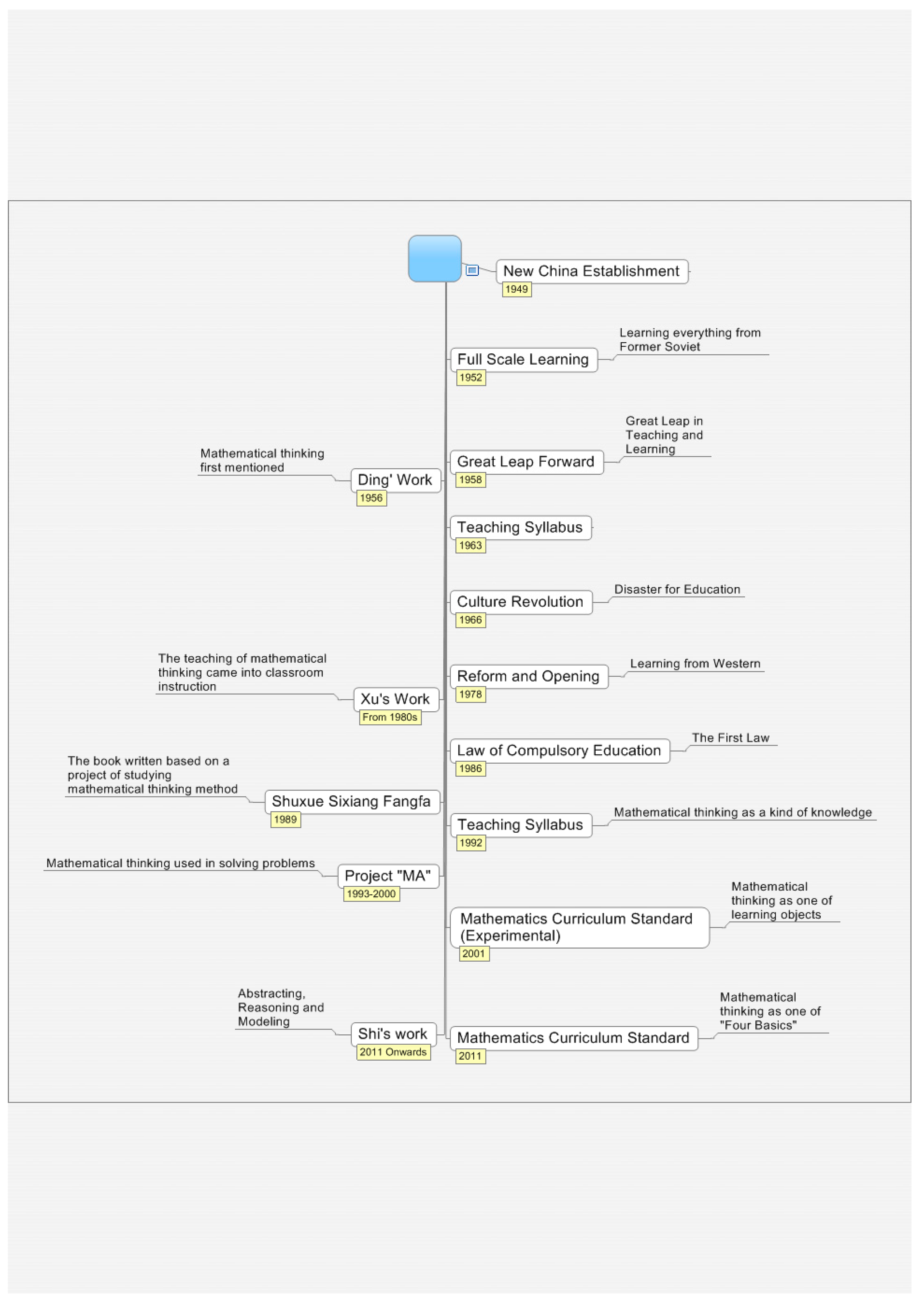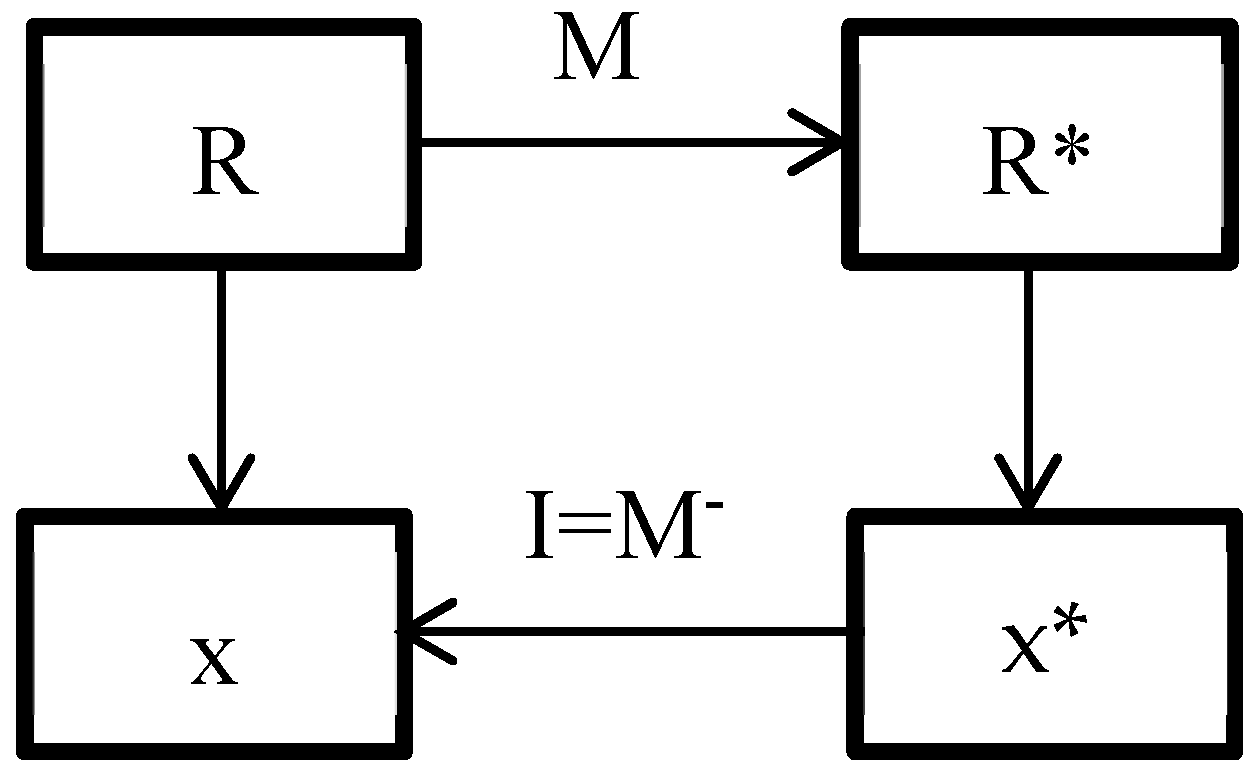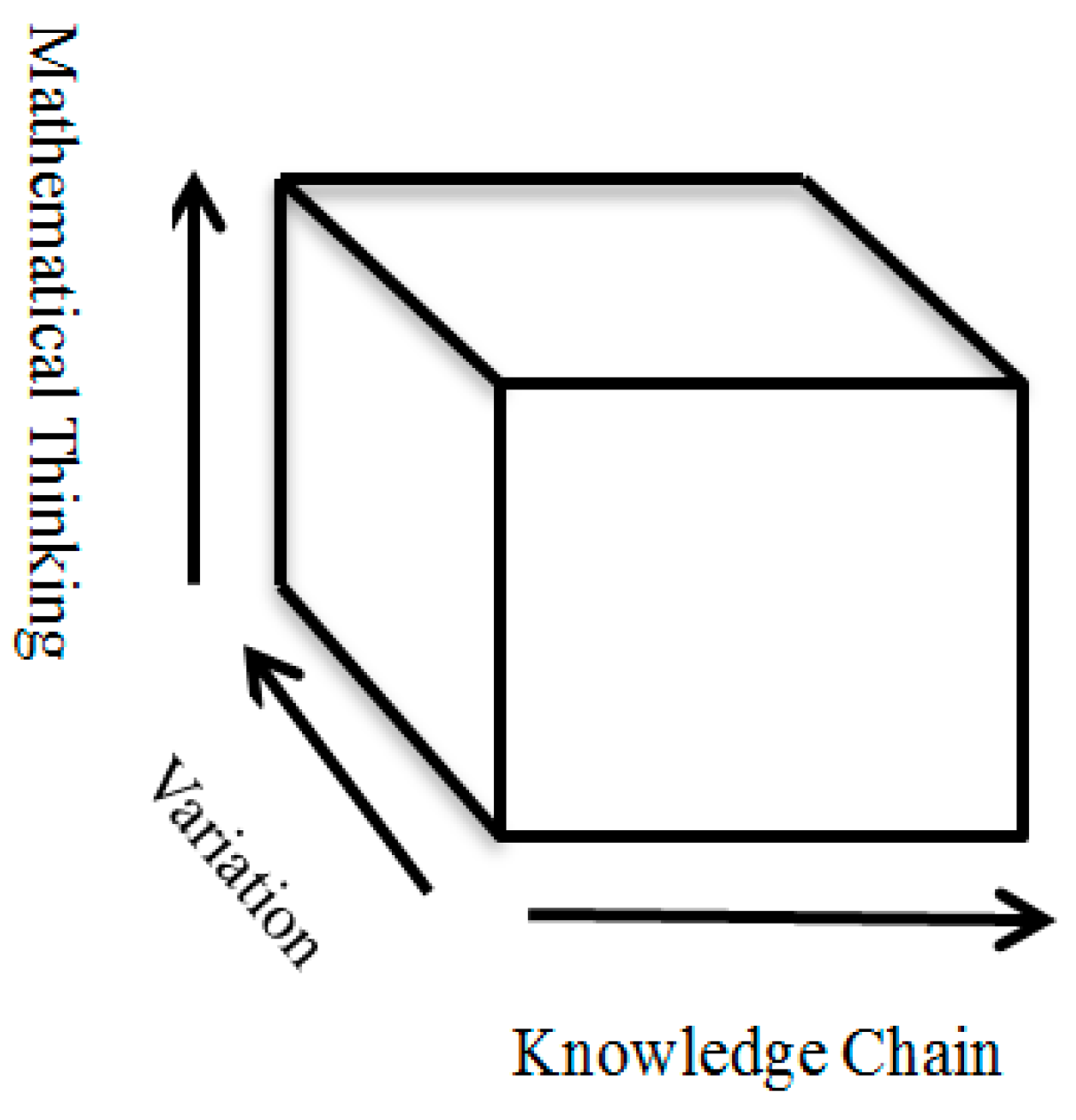The Evolution of Mathematical Thinking in Chinese Mathematics Education
Abstract
:1. Introduction
2. Research Method
2.1. Data Selection
2.1.1. Keywords in Chinese Determined
2.1.2. Data Sources
2.1.3. Data Selection
2.2. Data Analysis
Text 1: “basic knowledge means basic concepts, principles, properties, formulas, axioms, theorems and the mathematical thinking and method reflected by mathematical content”.[22] (p. 1)
Text 2: “They may have the following types. The first type is strategical thinking including thinking about transformation, …, etc. The second type is logical thinking including deduction, … etc. The third type is manual thinking including thinking about construction, discriminant of a quadric equation in one unknown, etc.…”.[29]
Text 3 MT is reflected in the process of knowledge establishment, development and application, is the abstraction and generalization of mathematical content and method in a higher level, such as abstracting, sorting, generalizing, deducting and modeling.[25] (p. 46)
3. Findings
3.1. Earlierst Explanations Given By Ding
3.2. Explanations Given by Researchers from the Persepctives of Methodology and Method (1980–1991)
3.2.1. Mathematical Methodology
Mathematical methodology is a discipline which aims to study and discuss the patterns of mathematical development, method of mathematical thinking and principles of mathematical findings, inventions and innovation.
Letting R represents a group of the relationship structures of original images and suppose the group contains x, which is an original image and to be determined. Then, letting M is a map whose function assumed that R can be mapped into relation structures of mapping image, R*, which contains the mapping image x* whose original image is x. If there was a way to determine x*, x could be known by the inversion, namely the inverse mapping, I = M−1.[28] (p. 25)
3.2.2. Mathematical Thinking Method
In the narrow sense level, mathematical thinking method refers to mathematical argumentation, operations, and thinking, methods and strategies for mathematical application.[29] (pp. 1–2)
In the broad sense level, apart from the considerations in the narrow sense, mathematical objectives, properties, characteristics, roles, development patterns for mathematics (such as concepts, theories, methods and forms) should be included.[29] (pp. 1–2)
3.3. MT and Mathematical Method Stated in the Teaching Syllabus(1992–2001)
The basic knowledge means basic concepts, principles, properties, formulas, axioms, theorems and the mathematical thinking and methods reflected by mathematical contents.[22] (p. 1)
3.3.1. Definition of MT
the space-forms and quantity relationships in real life reflected in human’s consciousness and then processed by human’s thinking, the products of thinking was mathematical thinking.[41]
3.3.2. MT and Mathematical Method
3.3.3. Types of MT
3.4. Mathematical Thinking Method Stated in the Curriculum Standard (2002–2011)
… should obtain the important mathematical knowledge including mathematical facts and activity experience, basic mathematical thinking method and basically mathematical application skills which are necessary for their future society life and further self-development.[25] (p. 3)
3.4.1. Mathematical Thinking Method
3.4.2. Major Types of MT
3.4.3. The Teaching of MT
3.5. MT as One of “Four Basics”in Curriculum Standard 2011 (From 2011–2018)
3.5.1. Explanations Given for MT
MT is reflected in the process of knowledge establishment, development and application, is the abstraction and generalization of mathematical content and method in a higher level, such as abstracting, sorting, generalizing, deducting and modeling.[6] (p. 46)
3.5.2. Major Types of MT
3.5.3. Teaching of MT
3.6. Conclusions and Discussions
3.6.1. The Struggling Relationship between MT and Mathematical Methods (methodology)
3.6.2. Involvement in Mathematical Thought Process
3.6.3. Focus on the Classification of MT
Author Contributions
Funding
Acknowledgments
Conflicts of Interest
References
- Stacey, K. (Ed.) What is mathematical thinking and why is it important. In Proceedings of the APEC-Tsukuba International Conference 2007: Innovative Teaching of Mathematics Through Lesson Study(ii), Focusing on mathematical Thinking, Tsukuba, Japan, 2–7 December 2006. [Google Scholar]
- Papadakis, S.; Kalogiannakis, M.; Zaranis, N. Improving mathematics teaching in kindergarten with Realistic Mathematical Education. Early Childhood Educ. J. 2016, 45, 369–378. [Google Scholar] [CrossRef]
- Dong, L.; Clarke, D.; Cao, Y.; Wang, L.; Seah, WT. Teacher Questioning Practices over a Sequence of Consecutive Lessons: A Case Study of Two Mathematics Teachers. Sustainability 2019, 11, 139. [Google Scholar] [CrossRef]
- Stigler, J.W.; Perry, M. Cross cultural studies of mathematics teaching and learning: Recent findings and new directions. In Perspectives on Research on Effective Mathematics Teaching; Grouws, D., Cooney, T., Eds.; Lawrence Erlbaum Associates Inc.: Hillsdale, NJ, USA, 1988; pp. 194–223. [Google Scholar]
- Stigler, J.W. Research into practice: The use of verbal explanation in Japanese and American classrooms. Arith. Teach. 1988, 36, 27–29. [Google Scholar]
- Zhang, D. The features of mathematics education in China (In Chinese). People’s Education 2010, 1, 36–38. [Google Scholar]
- Cai, J.; Nie, B. Problem solving in Chinese mathematics education: Research and practice. Zentralblatt für Didaktik der Mathematik (ZDM) 2007, 39, 459–473. [Google Scholar] [CrossRef]
- Lapointe, A.E.; Mead, N.A.; Phillips, G.W. A World of Difference: An International Assessment of Mathematics and SCience; Educational Testing Service: Princeton, NJ, USA, 1989. [Google Scholar]
- PISA 2012 Results in Focus: What 15-year-olds know and what they can do with what they know [Internet]. 2014. Available online: http://www.oecd.org/pisa/keyfindings/pisa-2012-results-overview.pdf (accessed on 26 August 2014).
- Leung, K.S.F. IEA Studies in Mathematics and Science. Int. Ency. Educ. 2010, 4, 650–655. [Google Scholar]
- Schoenfeld, A.H. Foreword. How Chinese Teach Mathematics and Improving Teaching; Routledge: New York, NY, USA, 2013; pp. xi–xv. [Google Scholar]
- Li, Y.; Zhang, J.; Ma, T. School mathematics textbook design and development practices in China. In Mathematics Curriculum in School Education; Li, Y., Lappan, G., Eds.; Springer: Dordrecht, The Netherland, 2014; pp. 305–326. [Google Scholar]
- Liu, J.; Li, Y. Mathematics curriculum reform in the Chinese mainland: Changes and challenges. In Reforms and Issues in School Mathematics in East Asia: Sharing and Understadning Mathematics Education Policies and Practices; Leung, F.K.S., Li, Y., Eds.; Sense Publishers: Rotterdam, The Netherlands, 2010; pp. 9–31. [Google Scholar]
- Ministry of Education PRC. Mathematics Curriculum Standard for Compulsory Education (2011 version); Beijing Normal University Publishing Group: Beijing, China, 2012. (In Chinese)
- Sun, X. Four basics: The most important achievement of mathematics currculum reforms in the recent decade. Basic Educ. Course J. 2011, Z2, 34–37. (In Chinese) [Google Scholar]
- Cui, Y.; Kong, F. The analysis and strategies for the issues in implementing "Four Basic". J. Chin. Soc. Educ. 2014, 3, 53–57. (In Chinese) [Google Scholar]
- Shi, N. The basic mathematical thinking. Shuxue Tongbao 2011, 50, 1–9. (In Chinese) [Google Scholar]
- Zhu, C. Discussions on the teaching of mathematical thinking method. Shuxuetongxun 2004, 9, 5–7. (In Chinese) [Google Scholar]
- Tang, H.; Peng, A.; Cheng, B.; Kuang, K.; Song, N. Characteristics of “Two Basics” teaching in secondary mathematics classrooms in China. In How Chinese Teach Mathematics and Improve Teaching; Li, Y., Huang, R., Eds.; Routledge: New York, NY, USA, 2013. [Google Scholar]
- Ding, R.; Wong, N.Y. Mathematics curriculum reform in China: Latest development and challenges. In Curriculum Reform in China; Yin, H.-B., Lee, J.C.-K., Eds.; Nova Science Publishers, Inc.: New York, NY, USA, 2012; pp. 81–93. [Google Scholar]
- Shao, G.; Fan, Y.; Huang, R.; Ding, E.; Li, Y. Mathematics classroom instruction in China viewed from a historical perspective. In How Chinese Teach Mathematics and Improve Teaching; Li, Y., Huang, R., Eds.; Routledge: New York, NY, USA, 2013; pp. 11–28. [Google Scholar]
- Zhang, D.; Li, S.; Tang, R. The “Two Basics”: Mathematics teaching and learning in mainland China. In How Chinese Learn Mathematics: Perspectives from Insiders. 1; Lianghuo, F., Ngai-Ying, W., Cai, J., Li, S., Eds.; World Scientific Publishing: Singapore, 2004; pp. 189–201. [Google Scholar]
- Bowen, G.A. Document analysis as a qualitative research method. Qual. Res. J. 2009, 9, 27–40. [Google Scholar] [CrossRef]
- Merriam, S.B. Case Study Research in Education: A Qualitative Approach; Jossey-Bass: San Francisco, CA, USA, 1988. [Google Scholar]
- Fereday, J.; Muir-Cochrane, E. Demonstrating rigor using thematic analysis: A hybrid approach of inductive and deductive coding and theme development. Int. J. Qual. Methods 2006, 5, 80–92. [Google Scholar] [CrossRef]
- Huberman, M.; Miles, M.B. The Qualitative Researcher’s Companion; Sage: Thousand Oaks, CA, USA, 2002. [Google Scholar]
- Strauss, A.; Corbin, J.M. Grounded Theory in Practic; SAGE Publications, Inc.: London, UK, 1997. [Google Scholar]
- Strauss, A.; Corbin, J. Basics of Qualitative Research: Grounded Theory and Procedures and Techniques; SAGE Publications, Inc.: Thousand Oaks, CA, USA, 1990. [Google Scholar]
- Sun, C.; Zang, L. A literature review on mathematical thinking. Maths Teach. Middle Sch. 2002, 10, 28–30. (In Chinese) [Google Scholar]
- Xu, B. The development of school mathematics textbooks in China since 1950. Zentralblatt für Didaktik der Mathematik (ZDM) 2013, 45, 725–736. [Google Scholar] [CrossRef]
- Li, Y. Lecture on mathematical thinking and mathematical method 2009. Available online: http://mingshi.qlteacher.com/studio/xuguangmin/Article/12816 (accessed on 13 December 2018).
- Ministry of Education PRC. Junior Secondary School Mathematics Teaching Syllabus for Full-Time Nine-Year Compulsory Education; People’s Education Press: Beijing, China, 1992. (In Chinses)
- Sun, X. Mathematics curriculum standards of China: Its process, strategies, outcomes and difficulties. In Mathematics Curriculum in Pacific rim Countries—China, Japan, Korea, and Singapore; Usisikin, Z., Willmore, E., Eds.; Information Age Publishing, Inc.: Charlotte, NC, USA, 2008; pp. 73–82. [Google Scholar]
- Lv, S.; Ye, P. The features and implications of curriculum objects for secondary school mathematics in China from the year of 1949. Shuxue Jiaoxue Yanjiu 2013, 32, 2–9. (In Chinese) [Google Scholar]
- Ministry of Education PRC. Mathematics Curriculum Standard for Full-Time Compulsory Education (Experimental vrsion); Beijing Normal University Publishing Group: Beijing, China, 2001. (In Chinese)
- Ding, S. The development of mathematical thinking (In Chinese). J. Dialectics Nat. 1956, 15–16. [Google Scholar]
- Xu, L. Topics in Mathematical Methodology. In Topics in Mathematical Methodology; Hua Zhong Gong Xue Yuan Chu Ban She: Wuhan, China, 1983. (In Chinese) [Google Scholar]
- Xu, L. Topics in Mathematical Methodology (2nd version); Hua Zhong Gong Xue Yuan Chu Ban She: Wuhan, China, 1988. (In Chinese) [Google Scholar]
- Xie, E.; Xu, B. (Eds.) Mathematical Thinking Method; Shandong Education Press: Jinan, China, 1989. (In Chinese) [Google Scholar]
- Luo, Z. The teaching of mathematical thinking method. Zhongxuejiaoyan 2004, 7, 28–33. (In Chinese) [Google Scholar]
- Zang, L. The report of the teaching experiment "Developing students’ mathematical thinking & Imporving students’ mathematical literacy". Curiculum Teach. Mater. Method 1997, 8, 35–39. (In Chinese) [Google Scholar]
- Qu, l. Disscussion on mathematical thinking. J. Math. Educ. 1994, 3, 32–35. [Google Scholar]
- Zhang, J. Form, content, mathematical thinking method and the teaching process. Shuxue Tongbao 1998, 11, 2–4. (In Chinese) [Google Scholar]
- Zang, L. An analysis of mathematical thinking and its features. Maths Teach. Middle Sch. 1998, 5, 1–2. (In Chinese) [Google Scholar]
- Cai, S. Mathematical thinking and mathematical method. Zhongxueshuxue 1997, 9, 1–4. (In Chinese) [Google Scholar]
- Zhang, D.; Guo, B. The Draft of Mathematical Methodology; Shanghai Education Publisher: Shanghai, China, 1996. (In Chinese) [Google Scholar]
- Zheng, Y. Mathematical thinking, mathematical thinking method and mathematical methodology. Sci. Technol. Dialectics 1993, 10, 1–7. (In Chinese) [Google Scholar]
- Wang, L. Practice and discussion on penetrating mathematical thinking method in primary school. Curiculum Teach. Mater. Method 2010, 30, 53–58. (In Chinese) [Google Scholar]
- Guo, L.; Chen, Y. Discussion on the educational value of mathematical thinking method. Theory Pract. Educ. 2005, 25, 59–60. (In Chinese) [Google Scholar]
- Liu, X. The role of mathematical thinking method in mathematics education. J. Cap. Norm. Univ. (Soc. Sci. Ed.) 2001, 2, 115–119. (In Chinese) [Google Scholar]
- Chen, Z. The teaching design of “Squared difference formula” presentation in the project of “Core concepts, theory and ways of thinking in teaching design”. J. Chin. Math. Educ. 2010, 7–8, 6–8. (In Chinese) [Google Scholar]
- Zhang, J.; Tao, W. Emphasizing the students’ thinking in learning the concept of function. Shuxue Tongbao 2009, 48, 19–25. (In Chinese) [Google Scholar]
- Xu, T.; Cheng, Z. Discussion on mathematical thinking method in the teaching of plane vector. Bull. Math. (Wuhan) 2001, 3, 22–23. (In Chinese) [Google Scholar]
- Wei, X.; Jiang, G. Mathematical thinking in probability and statistics content. J. Shaanxi Inst. Educ. 2003, 19, 67–69. (In Chinese) [Google Scholar]
- Zhong, Z.; Ning, L.; Bai, H. Discussion on the teaching tactics of mathematical thinking method. J. Math. Educ. 2007, 16, 13–16. (In Chinese) [Google Scholar]
- Hu, J. Discussion on the teaching of mathematical thinking method in a penetrating way with the help of GSP. Bull. Math. 2003, 1, 16–17. (In Chinese) [Google Scholar]
- Zhang, J. Sensing the power of mathematical thinking in primary school teaching for primary school mathemtics teachers. Renminjiaoyu 2007, 18, 32–35. (In Chinese) [Google Scholar]
- Gu, P. How "two basics" developed to "four basics" in mathematic education. J. Math. Educ. 2012, 21, 14–16. (In Chinese) [Google Scholar]
- Gu, P. Mathematical thinking also emphasized in primary school mathematics. Xiaoxuejiaoxue(Shuxue) 2012, 7–8, 14–18. Xiaoxuejiaoxue(Shuxue) 2012, 7–8, 14–18. (In Chinese) [Google Scholar]
- Liang, Q. Strategies for helping students develop matheamtical thinking. Curiculum Teach. Mater. Method 2015, 35, 54–58. (In Chinese) [Google Scholar]
- Liu, J. Major types of mathematical thinking and their meaning in primary school mathematics. Curiculum Teach. Mater. Method 2015, 35, 49–53. (In Chinese) [Google Scholar]
- Ma, Z. Emphasis on the teaching of mathematical thinking and deloping students mathematical thinking: An interview of Professor Qi Chunxia. Teacher’s J. 2013, 3–8. (In Chinese) [Google Scholar]
- Li, H. Emphasis on the teaching of mathematical thinking method--- " Core mathematical concepts and the structure of mathematical thinking and their teaching in theory and practice in middle school" (Summary of the sixth meeting for the topic). J. Chinese Math. Educ. 2011, 1–2, 11–13. (In Chinese) [Google Scholar]
- Zhang, D.; Fang, J. On the teaching of mathematical thinking method. Mon. J. High Sch. Math. 2012, 6, 1–3. (In Chinese) [Google Scholar]
- Gu, P. How to teach mathematical thinking in compulsory education phase. Jichujiaoyukecheng 2012, 103, 35–40. (In Chinese) [Google Scholar]
- Cheng, H. Reflection on the teaching of mathematical thinking method for secondary mathematics. Shuxue Tongbao 2012, 51, 28–32. (In Chinese) [Google Scholar]
- Kline, M. Mathematical Thought from Ancient to Modern Times (1); Shanghai Science and Technology Press: Shanghai, China, 1979. [Google Scholar]
- Kline, M. Mathematical Thought from Ancient to Modern Times (2); Shanghai Science and Technology Press: Shanghai, China, 1979. [Google Scholar]
- Kline, M. Mathematical Thought from Ancient to Modern Times (3); Shanghai Science and Technology Press: Shanghai, China, 1979. [Google Scholar]
- Kline, M. Mathematical Thought from Ancient to Modern Times (4); Shanghai Science and Technology Press: Shanghai, China, 1979. [Google Scholar]
- Solow, D. How to Read and Do Proofs: An Introduction to Mathematical Through Process; Science Press: Beijing, China, 1982. [Google Scholar]
- Yan, X. Review and implication of studies on modern mathematical thinking method. J. Math. Educ. 2008, 17, 84–88. (In Chinese) [Google Scholar]
- Shi, N. The future develpment of mathematics education. Math. Teach 2014, 1–3. (In Chinese) [Google Scholar]
- Lee, S.-Y. Mathematics learning and teaching in the school context: Reflections from cross-cultural comparisons. In Global Prospects for Education: Development, Culture, and Schooling; Garis, S.G., Wellman, H.M., Eds.; American Psychological Association: Washington, DC, USA, 1998; pp. 45–77. [Google Scholar]
- Schoenfeld, A.H. Looking toward the 21st century: Challenges of educational theory and practice. Educ. Res. 1999, 28, 4–14. [Google Scholar] [CrossRef]



| Source Database | CNKI | WANGFANG | CQVIP |
|---|---|---|---|
| Academic Journals | China Academic Journals Full-text Databases (1979); China Academic Journal Network Publishing Database (1915) | China Digital Journals Full-text Database (1998) s | China science and technology Journal Database (1989) |
| Doctoral Dissertations & Master Theses | Chinese Selected Doctoral Dissertations and Master’s Theses Full-text Databases (1984) | China Dissertation Full-text Database (1980) | N/A |
| Proceedings of Conference | China Proceedings of Conference Full-text Database (1953) | China Conference of Full-text Database (1985) | N/A |
| Newspapers | China Core Newspapers Full-text Database (2000) | N/A | China Science & Technology Economic News Database (1992) |
| Key Words | Before 1978 | 1979–1991 | 1992–2000 | 2001–2010 | 2011–2019Feb | Total |
|---|---|---|---|---|---|---|
| Official Documents | 1992 Teaching Syllabus | 2001 Curriculum Standard | 2011 Curriculum Standard | 3 | ||
| Journal Articles | 1 | 0 | 8 | 22 | 26 | 57 |
| Books | 0 | 3 | 3 | 3 | 1 | 10 |
| Total | 1 | 3 | 11 | 25 | 22 | 70 |
| Strategical | Logical | Manipulative |
|---|---|---|
| Thinking about transformation (Hua Gui) | Deducting | Construction |
| Abstracting & Briefly summarizing | Categorizing | Substitution |
| Thinking about equation & function (It means problem solving with function or equation) | Specializing | Undetermined coefficient method |
| Conjecturing | Analogizing | Method of completing the square |
| Thinking about symbolic-graphic combination | Generalizing | Parameters |
| Holistic & Systematic | Inversion | Discriminant |
| Abstracting | Reasoning | Modeling | Aesthetic |
|---|---|---|---|
| Categorization | Generalization | Simplify | Concise |
| Set | Deduction | Quantify | Symmetry |
| Constant in changing | Axiomatic | Equation | Uniform |
| Symbolic | Number-Graph Combination | Function | Express complex through simple |
| Corresponding | Conversion | Optimization | Perceive the essence from appearance |
| Finite and infinite | Associate &Analogy | Random | |
| Specialization and generalization | Statistic |
© 2019 by the authors. Licensee MDPI, Basel, Switzerland. This article is an open access article distributed under the terms and conditions of the Creative Commons Attribution (CC BY) license (http://creativecommons.org/licenses/by/4.0/).
Share and Cite
Li, N.; Mok, I.A.C.; Cao, Y. The Evolution of Mathematical Thinking in Chinese Mathematics Education. Mathematics 2019, 7, 297. https://doi.org/10.3390/math7030297
Li N, Mok IAC, Cao Y. The Evolution of Mathematical Thinking in Chinese Mathematics Education. Mathematics. 2019; 7(3):297. https://doi.org/10.3390/math7030297
Chicago/Turabian StyleLi, Na, Ida Ah Chee Mok, and Yiming Cao. 2019. "The Evolution of Mathematical Thinking in Chinese Mathematics Education" Mathematics 7, no. 3: 297. https://doi.org/10.3390/math7030297
APA StyleLi, N., Mok, I. A. C., & Cao, Y. (2019). The Evolution of Mathematical Thinking in Chinese Mathematics Education. Mathematics, 7(3), 297. https://doi.org/10.3390/math7030297






